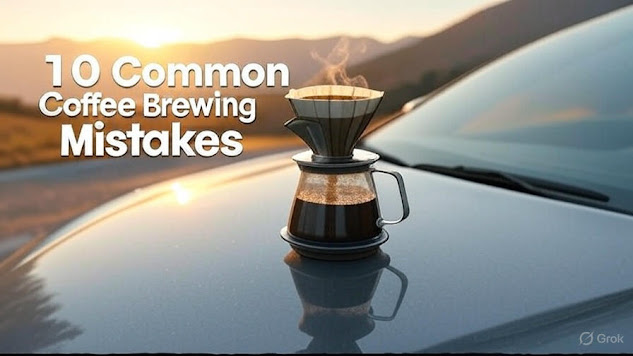10 Common Coffee Brewing Mistakes and How to Avoid Them
Updated for 2025
Introduction
Brewing the perfect cup of coffee is both an art and a science. Whether you're using a French press, pour-over, espresso machine, or a basic drip brewer, small mistakes can drastically affect taste, aroma, and overall satisfaction.
In this article, we'll explore 10 of the most common coffee brewing mistakes people make—and more importantly, how to avoid them. If you're serious about leveling up your home coffee game in 2025, this guide is for you.
1. Using Stale Coffee Beans
The Mistake:
Buying ground coffee in bulk and storing it for weeks or even months.
Why It Matters:
Coffee starts losing its flavor and aroma shortly after roasting. Stale beans produce a flat or bitter brew.
How to Avoid It:
-
Buy freshly roasted beans from local roasters or trusted online sources.
-
Use beans within 2–3 weeks of the roast date.
-
Store them in an airtight container away from light and moisture—never in the fridge!
2. Incorrect Grind Size
The Mistake:
Using the same grind for all brewing methods.
Why It Matters:
Grind size controls extraction time. Too fine and your coffee may taste bitter; too coarse and it might be weak or sour.
How to Avoid It:
-
Espresso: Fine grind
-
Pour-over: Medium-fine
-
Drip machine: Medium
-
French press: Coarse
Invest in a burr grinder for consistent results.
3. Using the Wrong Water Temperature
The Mistake:
Pouring boiling water over coffee or using water that’s too cool.
Why It Matters:
Water that's too hot over-extracts the coffee, making it bitter. Cold water under-extracts, leaving it sour or weak.
How to Avoid It:
Use water between 195°F to 205°F (90°C to 96°C). Let boiled water sit for 30 seconds before pouring if you don’t have a thermometer.
4. Poor Quality Water
The Mistake:
Using tap water that contains chlorine or minerals.
Why It Matters:
Since coffee is over 98% water, poor-quality water can ruin even the best beans.
How to Avoid It:
Use filtered water or bottled spring water with balanced minerals (not distilled). Some coffee lovers invest in water filtration systems or TDS testers.
5. Wrong Coffee-to-Water Ratio
The Mistake:
Eyeballing your brew or guessing how much coffee to use.
Why It Matters:
Too much coffee = bitter brew. Too little = weak and watery.
How to Avoid It:
Use the Golden Ratio:
1:15 to 1:18 (1 gram of coffee to 15–18 grams of water).
Start with 15g coffee to 250g water and adjust to taste.
Use a digital scale for precision.
6. Not Pre-Wetting the Coffee Filter
The Mistake:
Placing dry filters directly into the machine or dripper.
Why It Matters:
Unrinsed paper filters add a papery taste to the coffee.
How to Avoid It:
Rinse your paper filter with hot water before adding coffee. This also preheats your brewing equipment, helping maintain temperature stability.
7. Inconsistent Brew Time
The Mistake:
Letting coffee steep too long or not long enough.
Why It Matters:
Brew time impacts extraction—the process of pulling flavor compounds from the coffee grounds.
How to Avoid It:
Use a timer!
-
French press: ~4 minutes
-
Pour-over: 2.5–3.5 minutes
-
Espresso: 25–30 seconds
8. Skipping Equipment Cleaning
The Mistake:
Only rinsing coffee makers and grinders occasionally.
Why It Matters:
Old coffee oils and residues build up and affect flavor, adding bitterness or musty notes.
How to Avoid It:
-
Clean your coffee maker weekly.
-
Use vinegar or coffee cleaning tablets for deeper cleaning.
-
Disassemble and clean grinders regularly.
9. Using Pre-Ground Coffee
The Mistake:
Buying ground coffee instead of grinding fresh beans.
Why It Matters:
Ground coffee oxidizes quickly, losing flavor within minutes.
How to Avoid It:
Always grind your beans fresh, just before brewing. A quality burr grinder is a worthwhile investment for flavor consistency.
10. Neglecting Brew Method Matching
The Mistake:
Using any coffee for any method—like using espresso roast in a French press.
Why It Matters:
Different brewing methods extract flavors differently. Not all beans are suited for every method.
How to Avoid It:
Choose beans roasted and ground for your specific brew style:
-
Light roast for pour-over
-
Medium roast for drip
-
Dark roast for espresso
Ask your roaster or supplier for recommendations.
Bonus Tip: Keep a Brew Journal
If you're serious about improving, consider keeping a small log. Track:
-
Bean origin and roast date
-
Grind size
-
Brew time
-
Water temp
-
Taste notes
Over time, this helps you find your perfect cup and avoid repeating mistakes.
Final Thoughts
Brewing better coffee at home doesn’t require fancy machines—it just takes attention to detail and a little knowledge. By avoiding these common mistakes, you can dramatically improve the taste, aroma, and satisfaction of every cup.
Whether you're a beginner or a seasoned coffee lover, the journey to brewing perfection is ongoing. But now, you're equipped with the knowledge to avoid the pitfalls that plague many home brewers.
Ready to take your coffee to the next level?
Check out our other brewing guides, gear reviews, and recipes to explore the full world of coffee—from bean to cup.



Post a Comment